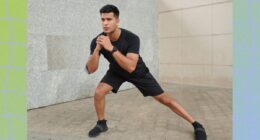Weight gain can be attributed to family history, an unhealthy diet, a lack of movement, hormonal issues and medications.
While there is “no single solution” to lose weight, the doctors encourage anybody who wants to shed the pounds to “try yoga”.
Dr Anekwe verified: “There is good research that yoga may help you manage stress, improve your mood, curb emotional eating, and create a community of support, all of which can help with weight loss and maintenance.
“Yoga can also help you burn calories, as well as increase your muscle mass and tone.”
The holistic mind-body practice is a stress-easing activity that can help to lower cortisol levels, which would otherwise contribute to fat build-up and sugar cravings.
Dr Reddy confirmed to Harvard Health Medical School that yoga’s benefits “extend beyond the calories-in-versus-calories-out equation”.
The moving meditation can make you more aware of your body and could negate the desire to binge eat, stress eat, or to eat just for the sake of it.
Types of yoga
MindBodyGreen pointed out eleven major styles of yoga, from Vinyasa to Hatha and Iyengar yoga.
Vinyasa yoga
OneFlow Yoga explained: “Vinyasa is a style of yoga characterized by stringing postures together so that you move from one to another, seamlessly, using breath.”
Hatha yoga
EkhartYoga regarded Hatha yoga as more slow than Vinyasa, with some poses required to be held for a certain amount of time.
Iyengar yoga
MindBodyGreen said: “Generally, poses are held for a long time while adjusting the minutiae of the pose.
“Iyengar relies heavily on props to help students perfect their form and go deeper into poses in a safe manner.”
This type of yoga is recommended for people who have injuries and so require a slow and methodical practice.
Kundalini yoga
On the other side of the spectrum is the fast-moving Kundalini yoga practice which is all about releasing “trapped” energy.
Such classes focus on spirituality and can involve chanting, mantra, and meditation.
Bikram yoga
Set in a sauna-like room, hot yoga can make you drip with sweat which may feel more like a workout.
The sequence remains the same and includes a set of 26 basic postures, with each one performed twice.










